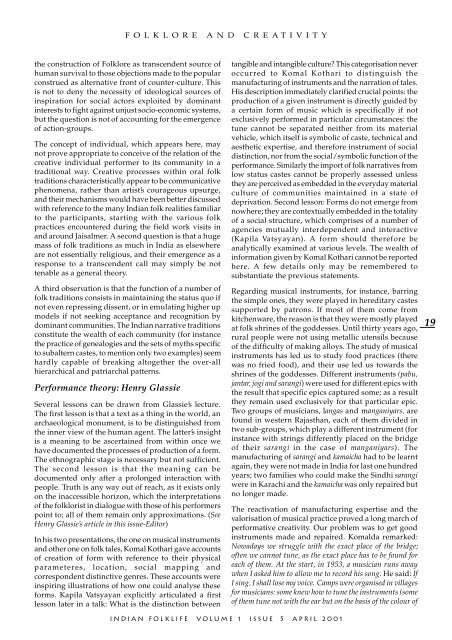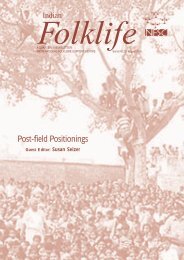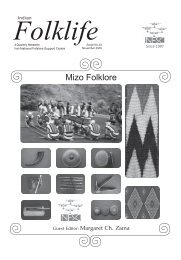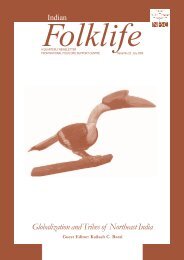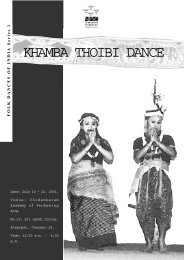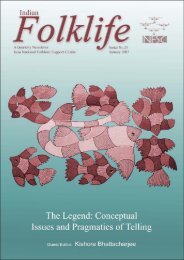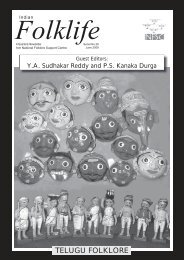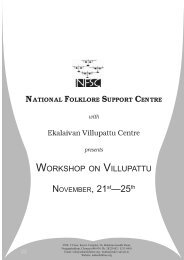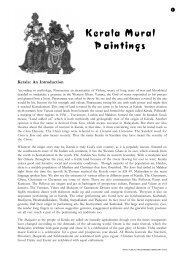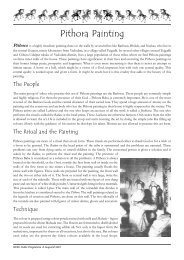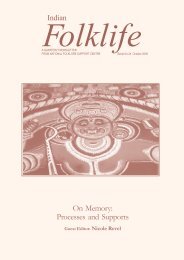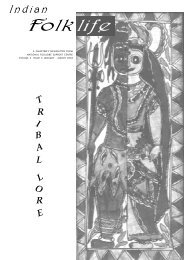THE ADVENT OF ASIAN CENTURY IN FOLKLorE - Wiki - National ...
THE ADVENT OF ASIAN CENTURY IN FOLKLorE - Wiki - National ...
THE ADVENT OF ASIAN CENTURY IN FOLKLorE - Wiki - National ...
Create successful ePaper yourself
Turn your PDF publications into a flip-book with our unique Google optimized e-Paper software.
FOLKLORE AND CREATIVITYthe construction of Folklore as transcendent source ofhuman survival to those objections made to the popularconstrued as alternative front of counter-culture. Thisis not to deny the necessity of ideological sources ofinspiration for social actors exploited by dominantinterests to fight against unjust socio-economic systems,but the question is not of accounting for the emergenceof action-groups.The concept of individual, which appears here, maynot prove appropriate to conceive of the relation of thecreative individual performer to its community in atraditional way. Creative processes within oral folktraditions characteristically appear to be communicativephenomena, rather than artist’s courageous upsurge,and their mechanisms would have been better discussedwith reference to the many Indian folk realities familiarto the participants, starting with the various folkpractices encountered during the field work visits inand around Jaisalmer. A second question is that a hugemass of folk traditions as much in India as elsewhereare not essentially religious, and their emergence as aresponse to a transcendent call may simply be nottenable as a general theory.A third observation is that the function of a number offolk traditions consists in maintaining the status quo ifnot even repressing dissent, or in emulating higher upmodels if not seeking acceptance and recognition bydominant communities. The Indian narrative traditionsconstitute the wealth of each community (for instancethe practice of genealogies and the sets of myths specificto subaltern castes, to mention only two examples) seemhardly capable of breaking altogether the over-allhierarchical and patriarchal patterns.Performance theory: Henry GlassieSeveral lessons can be drawn from Glassie’s lecture.The first lesson is that a text as a thing in the world, anarchaeological monument, is to be distinguished fromthe inner view of the human agent. The latter’s insightis a meaning to be ascertained from within once wehave documented the processes of production of a form.The ethnographic stage is necessary but not sufficient.The second lesson is that the meaning can bedocumented only after a prolonged interaction withpeople. Truth is any way out of reach, as it exists onlyon the inaccessible horizon, which the interpretationsof the folklorist in dialogue with those of his performerspoint to; all of them remain only approximations. (SeeHenry Glassie’s article in this issue-Editor)In his two presentations, the one on musical instrumentsand other one on folk tales, Komal Kothari gave accountsof creation of form with reference to their physicalparameteres, location, social mapping andcorrespondent distinctive genres. These accounts wereinspiring illustrations of how one could analyse theseforms. Kapila Vatsyayan explicitly articulated a firstlesson later in a talk: What is the distinction betweentangible and intangible culture? This categorisation neveroccurred to Komal Kothari to distinguish themanufacturing of instruments and the narration of tales.His description immediately clarified crucial points: theproduction of a given instrument is directly guided bya certain form of music which is specifically if notexclusively performed in particular circumstances: thetune cannot be separated neither from its materialvehicle, which itself is symbolic of caste, technical andaesthetic expertise, and therefore instrument of socialdistinction, nor from the social/symbolic function of theperformance. Similarly the import of folk narratives fromlow status castes cannot be properly assessed unlessthey are perceived as embedded in the everyday materialculture of communities maintained in a state ofdeprivation. Second lesson: Forms do not emerge fromnowhere; they are contextually embedded in the totalityof a social structure, which comprises of a number ofagencies mutually interdependent and interactive(Kapila Vatsyayan). A form should therefore beanalytically examined at various levels. The wealth ofinformation given by Komal Kothari cannot be reportedhere. A few details only may be remembered tosubstantiate the previous statements.Regarding musical instruments, for instance, barringthe simple ones, they were played in hereditary castessupported by patrons. If most of them come fromkitchenware, the reason is that they were mostly playedat folk shrines of the goddesses. Until thirty years ago,rural people were not using metallic utensils becauseof the difficulty of making alloys. The study of musicalinstruments has led us to study food practices (therewas no fried food), and their use led us towards theshrines of the goddesses. Different instruments (pabu,jantar, jogi and sarangi) were used for different epics withthe result that specific epics captured some; as a resultthey remain used exclusively for that particular epic.Two groups of musicians, langas and manganiyars, arefound in western Rajasthan, each of them divided intwo sub-groups, which play a different instrument (forinstance with strings differently placed on the bridgeof their sarangi in the case of manganiyars). Themanufacturing of sarangi and kamaicha had to be learntagain, they were not made in India for last one hundredyears; two families who could make the Sindhi sarangiwere in Karachi and the kamaicha was only repaired butno longer made.The reactivation of manufacturing expertise and thevalorisation of musical practice proved a long march ofperformative creativity. Our problem was to get goodinstruments made and repaired. Komalda remarked:Nowadays we struggle with the exact place of the bridge;often we cannot tune, as the exact place has to be found foreach of them. At the start, in 1953, a musician runs awaywhen I asked him to allow me to record his song. He said: IfI sing, I shall lose my voice. Camps were organised in villagesfor musicians: some knew how to tune the instruments (someof them tune not with the ear but on the basis of the colour of19<strong>IN</strong>DIAN FOLKLIFE VOLUME 1 ISSUE 5 APRIL 2001


